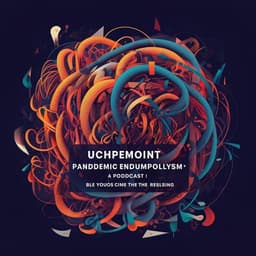
Political Science
Image restoration strategies in pandemic crisis communication: a comparative analysis of Chinese and American COVID-19 political speeches
X. Wang, S. Kaur, et al.
This fascinating study by Xiping Wang, Surinderpal Kaur, Noor Aqsa Nabila Mat Isa, and Sheena Kaur delves into the image restoration strategies employed in COVID-19 political speeches from Chinese and American leaders. It uncovers how these leaders shape national images during crises and the implications this has for communication and ideology.
~3 min • Beginner • English
Introduction
The COVID-19 pandemic thrust political leaders into the spotlight to manage health risks, shape public opinion, and counter disinformation through transparent, timely, and accurate messaging. Given the strained Sino–US relationship and mutual blame during COVID-19, both countries faced significant reputational damage (e.g., questions over virus origin, early US mismanagement). This study addresses a comparative gap in the literature by examining how top Chinese and American leaders used image restoration strategies to manage domestic and international perceptions over the course of the pandemic. Using Image Repair Theory (IRT), the study asks: (RQ1) What image restoration strategies are employed by Chinese and American leaders in pandemic crisis communication? (RQ2) How do these strategies contribute to US/China-led narratives on the pandemic? The purpose is to elucidate communicative tactics at the highest political levels and their implications for national ideologies and future crisis management.
Literature Review
Crisis communication research has expanded from corporate to interdisciplinary governmental analyses, covering pre-crisis, crisis, and post-crisis stages and diverse rhetorical strategies across countries. Prior work on US leaders (Trump, Biden, Harris, governors) identified communication styles, metaphors, discursive tactics, and the political consequences of ineffective responses, with particular critique of Trump's divisive framing. Chinese pandemic discourse studies highlight globalist and nationalist arguments, metaphor use, solidarity narratives, and health diplomacy, with attention to implications for the US-led order. Comparative Sino–US works remain limited in scope and timeframe. Identified gaps include a paucity of longitudinal, leader-comparative corpora and limited assessment of specific strategies and their global impact. Image Repair Theory (Benoit) posits that communication is goal-directed toward maintaining a positive reputation, offering strategies such as denial, evasion of responsibility, reducing offensiveness (bolstering, minimization, differentiation, transcendence, attack accuser, compensation), corrective action, and mortification. IRT has been applied in corporate and political contexts and is suited to analyzing leaders' dual challenge of crisis response and image management. The present study addresses gaps via a longitudinal, comparative, corpus-assisted discourse analysis anchored in IRT.
Methodology
Design: Mixed-methods corpus-assisted discourse analysis combined with qualitative content analysis grounded in Image Repair Theory (IRT). Tools: LancsBox 6.0 (Words, wizard, collocation modules), KIWC tool for semantic domain insights, ProtAnt for text selection.
Corpus construction: Two self-built corpora comprising pandemic-related press briefings and public speeches from top leaders (China: Xi Jinping, Li Keqiang, Wang Yi; US: Donald Trump, Joe Biden, Kamala Harris), collected from official government websites. Timeframe: March 2020 (WHO pandemic declaration) to December 2022 (end of China’s Dynamic Zero-COVID policy). Inclusion: head-of-government-level communications; Exclusion: non-leader ministers, Q&A sections, and irrelevant factual briefs. Files converted to TXT and tagged with time, speaker, and type.
Corpus statistics: Corpus of Chinese Leaders (CCL): 60 files; 113,171 tokens; 6,999 word types; 6,081 lemmas. Corpus of American Leaders (CAL): 84 files; 203,719 tokens; 10,574 word types; 9,708 lemmas.
Quantitative analysis: Generated wordlists and top frequency nouns; applied a pandemic wordlist (adapted from Oxford COVID Wordlist and Webster guide) via LancsBox wizard; categorized words into thematic clusters for each corpus. Collocation analysis focused on ‘Chinese’ (CCL) and ‘American’ (CAL), considering up to 3 words to the right; all collocates considered; grouped collocates into semantic domains (governance, culture/society, international relations, health/security, economy/development for ‘Chinese’; economy/development, leadership/community, resilience/achievements, public/people, innovation/ideals for ‘American’).
Qualitative analysis: Using IRT, selectively downsized to 20 representative texts per corpus (via search term frequency and ProtAnt) for close reading. Each line coded for IRT strategies (denial, evasion, reducing offensiveness subtypes, corrective action, mortification). Excerpts analyzed to exemplify strategy use across crisis stages.
Research questions: RQ1 identifies the strategies employed; RQ2 assesses how strategies contribute to each country’s pandemic narrative and image.
Key Findings
Corpus-level themes and frequencies:
- CCL top nouns emphasized geopolitical entities and cooperation (‘China’ 1,112), development (‘development’ 1,067; ‘cooperation’ 1,027; ‘economy’ 287; ‘trade’ 250), public health (‘covid-19’ 325; ‘health’ 229; ‘epidemic’ 176), and society/community (‘people’ 399; ‘community’ 228; ‘peace’ 180). These project a responsible, cooperative image, focusing on unity and economic stability.
- CAL top nouns stressed leadership/governance and national identity (‘president’ 1,147; ‘states’ 468; ‘America’ 257; ‘country’ 374), public health and vaccination (‘vaccine(s)’ 646; ‘vaccination’ 299; ‘shot(s)’ 476; ‘covid-19’ 280; ‘virus’ 268), community impact (‘people’ 964; ‘Americans’ 386), and temporal/global framing (‘time’ 410; ‘world’ 321; ‘week’ 199). This highlights decisive leadership, patriotism, and vaccine-led corrective action.
Pandemic wordlist differences (top 14 terms):
- CCL: ‘COVID-19’ (325), ‘epidemic’ (176), ‘pandemic’ (135), ‘virus’ (120), ‘vaccine’ (52). Emphasis on epidemic impact and anti-stigmatization.
- CAL: ‘vaccinated’ (558), ‘vaccine’ (388), ‘vaccination’ (299), ‘COVID-19’ (280), ‘mask’ (69), ‘reopen’ (46). Emphasis on vaccination, masking, and reopening.
Collocate semantic domains:
- ‘Chinese’ collocates (49 total) mapped to governance (e.g., ‘nation’ 20; ‘government’ 16), culture/society (‘people’ 91; ‘characteristics’ 13; ‘civilization’ 6), international cooperation (‘assistance’ 1), health/security (‘medical teams’ 2; ‘vaccines’ 2), and economy/development (‘economy’ 17; ‘companies’ 7). This indicates image repair via state leadership, cultural heritage, health diplomacy, and economic resilience.
- ‘American’ collocates (48 total) mapped to economy/development (‘companies’ 18), leadership/community (e.g., ‘Rescue Plan’ 21; ‘leadership’ 6), resilience/achievements (‘lives’ 11; ‘achievement’ 2), public/people (‘people’ 122; ‘adults’ 12), and innovation/ideals (‘science’ 2; ‘history’ 14). This frames image repair around policy leadership, societal resilience, and scientific progress.
Image Repair Theory (IRT) strategies observed in both corpora (all five categories present), with three prominently shared:
1) Reducing offensiveness:
- Bolstering: China highlighted leadership efficacy and civilizational heritage; US highlighted historical resilience (e.g., Trump 20200311; Biden 20211221).
- Differentiation (more in China): contrasted pandemic with greater global challenges to deflect politicization; emphasized governance and global cooperation.
- Minimization (more in US): downplayed domestic severity at times or reframed via global perspective (e.g., Trump 20200413; Biden 20210624).
- Attack accuser appeared in US cases (e.g., Trump critiquing WHO as “China-centric”, 20200415). Compensation elements present via aid/diplomacy references.
2) Mortification (without explicit apology): Both used person deixis to express empathy and collective responsibility. Pronoun frequencies: CCL ‘we’ 1,749 (60 texts), ‘our’ 586 (57), ‘us’ 240 (54); CAL ‘we’ 3,472 (82), ‘our’ 1,468 (82), ‘us’ 402 (64). ‘We can’: CCL 36; CAL 264. US leaders marked shared loss (e.g., 1 million deaths) and global solidarity; Chinese leaders stressed taking national/international responsibilities.
3) Corrective action:
- China: projected concrete and aspirational plans—economic recovery, business environment reforms, regional partnerships—framing resilience and responsible leadership (e.g., Wang Yi 20200215; Li Keqiang 20201015; Xi 20220125).
- US: foregrounded policy actions, vaccination rollout, expert authority (frequent references to Dr. Fauci, etc.; ‘Dr’ used 124 times in 26/84 texts), and bipartisan cues (e.g., Biden citing Trump’s booster). Political figures and health experts jointly reinforced credibility and solutions.
Overall narrative effects:
- China: responsible, cooperative, stable, culturally rooted leadership; emphasis on governance, unity, and global cooperation.
- US: confident, ambitious leadership with a leading geopolitical role; emphasis on decisive governance, vaccination, science, and national identity.
Discussion
The findings address RQ1 by demonstrating that both Chinese and American leaders used a full spectrum of IRT strategies, especially reducing offensiveness (with differing emphases—China on bolstering and differentiation; US on bolstering and minimization), mortification through empathetic inclusive pronouns, and corrective action via forward-looking plans and expert-backed measures. For RQ2, these strategies constructed divergent yet overlapping national narratives: China’s discourse foregrounded responsible governance, cultural heritage, economic resilience, and global cooperation; the US foregrounded presidential leadership, national identity, vaccination as corrective action, and scientific authority. These approaches sought to repair damaged reputations from early-pandemic critiques—China countering stigmatization and origin debates, the US countering perceptions of initial mismanagement—by reframing actions and values. The corpus evidence (keywords, pandemic wordlists, collocates) shows how linguistic choices align with strategic narratives, shaping public opinion domestically and internationally. The US reliance on vaccination and expert endorsement aimed to demonstrate effective, science-led governance, while China’s emphasis on cooperation and development projects projected reliability and international responsibility. Together, the results underscore the central role of discourse in legitimizing crisis responses and promoting national ideologies during global health emergencies.
Conclusion
This study integrates corpus-assisted discourse analysis with Image Repair Theory to compare Chinese and American leaders’ pandemic crisis communication. It shows both sides employed shared strategies—reducing offensiveness, mortification, and corrective action—yet with distinct emphases that shaped their national narratives. Chinese leaders framed a responsible, cooperative, and stable image rooted in governance, culture, and global partnership. American leaders constructed a confident, ambitious image anchored in strong leadership, vaccination-led public health, science, and national identity. Common keywords (world, people, COVID-19, health) reflect shared global stakes and the need for cooperation. Practically, the study highlights how leaders can strategically deploy credible, accurate crisis messages, empathetic inclusive language, and concrete corrective actions to manage reputational threats. Future research should broaden comparisons across regions, extend longitudinally to track evolving sentiments and policies, and integrate interdisciplinary perspectives and additional channels (e.g., social media, diplomatic communication) to deepen understanding of image repair in crises.
Limitations
The research focuses on two countries and top leaders’ speeches, offering depth but limited generalizability. It excludes other communication channels (e.g., social media), non-leader voices, and Q&A interactions. The longitudinal period (Mar 2020–Dec 2022) may not capture later evolutions. Future work should include broader cross-national and cross-continental comparisons, longer time horizons to track shifting public sentiment, interdisciplinary approaches (public health, political science, crisis management), and diverse channels (social media, diplomatic communications) for a holistic view.
Related Publications
Explore these studies to deepen your understanding of the subject.







